When it comes to the world of birds, there is a charming group of species that captures the hearts of nature enthusiasts with their delightful antics and endearing appearance. Known for their small size, cheerful disposition, and distinctive markings, chickadees have become beloved avian icons.
However, among the diverse array of winged creatures, there are other species that bear a striking resemblance to these charismatic birds. Join us as we explore a fascinating collection of avian counterparts, each possessing unique qualities that echo the beloved chickadee’s charm and allure.
- American Tree Sparrow
- White-Breasted Nuthatch
- Tufted Titmouse
- Black-Tailed Gnatcatcher
- Black-Throated Sparrow
- Blue-Gray Gnatcatcher
- Blackpoll Warbler
Types of Chickadee Species
- Gray-Headed Chickadee
- Carolina Chickadee
- Mountain Chickadee
- Boreal Chickadee
- Chestnut-Backed Chickadee
- Black-Capped Chickadee
- Mexican Chickadee
American Tree Sparrow

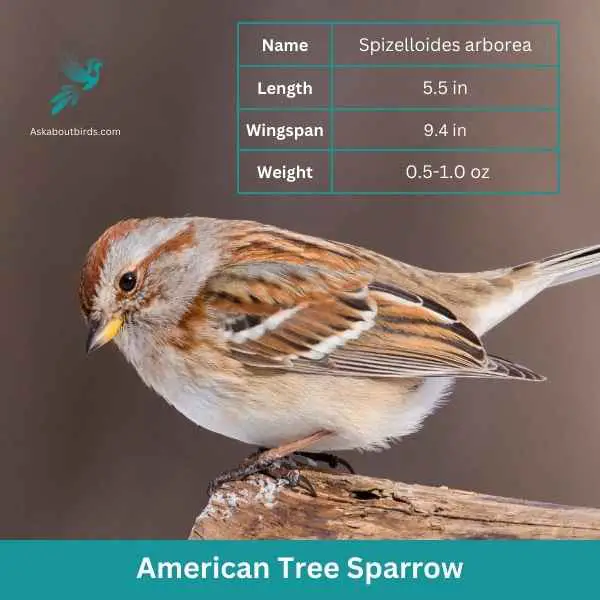
| Feature | Measurement |
|---|---|
| Scientific Name | Spizelloides arborea |
| Length | 5.5 in |
| Wingspan | 9.4 in |
| Weight | 0.5 – 1 oz |
The American Tree Sparrow is a small songbird found in northern North America during the breeding season and migrates southward for the winter. It has a distinct appearance with a rusty cap and streaked plumage, making it easily recognizable. These sparrows prefer shrubby habitats, such as open woodlands and hedgerows, where they forage on the ground for seeds, grasses, and berries.
They are known for their sweet and melodious songs, often heard during the breeding season. American Tree Sparrows build cup-shaped nests on the ground, hidden among grasses or shrubs, and females lay their eggs within. In winter, they often form flocks with other small birds, moving together in search of food and facing the challenges of colder climates.
Similarities
- Both are small birds, under 6 inches in length.
- Both species are small, songbirds, characterized by their melodious calls.
- They are both hardy birds that tolerate cold climates well and are known for their adaptability.
- Both species have some white on their underparts.
Differences
- Chickadees have a distinctive black cap and bib, white cheeks, and soft gray backs and wings, while American Tree Sparrows have a bicolored bill, a reddish cap, and a gray face with a dark eye line.
- American Tree Sparrows are more common in open habitats like tundra and fields, while Chickadees prefer deciduous and mixed forests.
White-Breasted Nuthatch
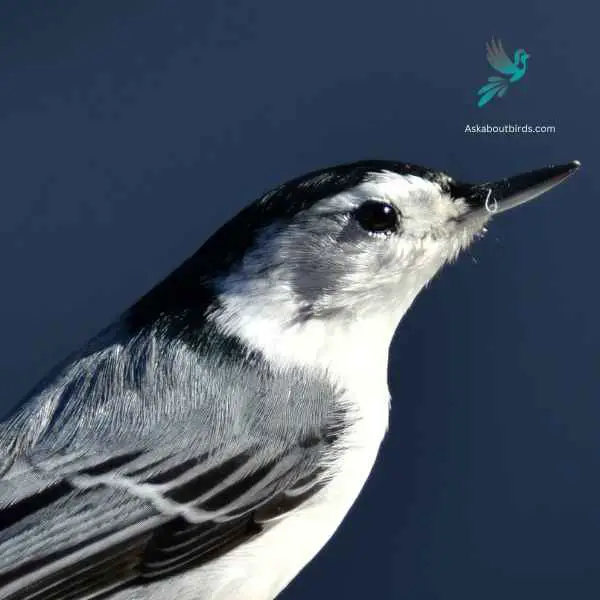

| Feature | Measurement |
|---|---|
| Scientific Name | Sitta carolinensis |
| Length | 6.1 in |
| Wingspan | 7.9–10.6 in |
| Weight | 0.63–1.06 oz |
The White-breasted Nuthatch is a small and charismatic songbird found in North America. It is known for its distinct appearance and unique behaviors. With its blue-gray upperparts, white underparts, and a black cap on its head, this nuthatch is easily identifiable.
These birds inhabit deciduous and mixed woodlands, where they forage along tree trunks and branches in search of insects and seeds. The White-breasted Nuthatch has a strong bill that it uses to probe and pry open crevices in the bark, allowing it to extract insects and gather hidden seeds. Their unique ability to move head-first down tree trunks sets them apart from other species.
Similarities
- Both species are agile and acrobatic feeders, often seen hanging upside down as they search for food.
- They are both cavity-nesters, often utilizing tree holes for nesting.
- Chickadees and White-Breasted Nuthatches share similar habitats, often being found in deciduous and mixed forests.
Differences
- While both birds have gray backs, Chickadees have a distinctive black cap and bib, and white cheeks, while White-Breasted Nuthatches have a white face and underparts and a black or gray cap.
- Nuthatches have a habit of moving headfirst down tree trunks, which Chickadees don’t do.
Tufted Titmouse

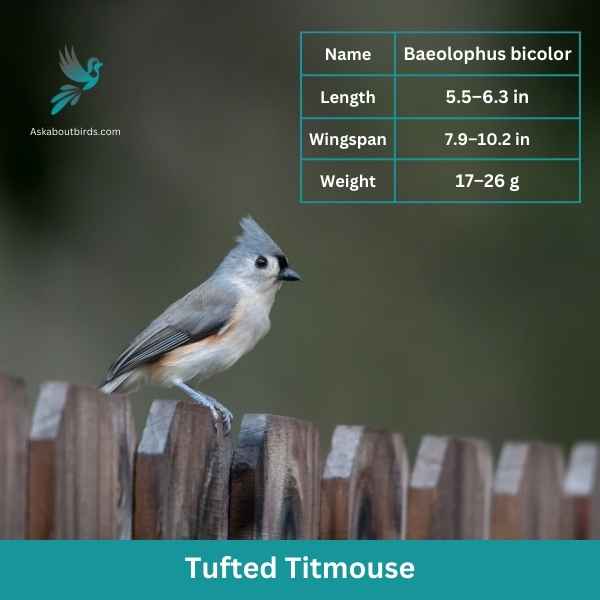
| Feature | Measurement |
|---|---|
| Scientific Name | Baeolophus bicolor |
| Length | 5.5–6.3 in |
| Wingspan | 7.9–10.2 in |
| Weight | 17–26 g |
The Tufted Titmouse, a small songbird native to eastern North America, is instantly recognizable with its gray plumage, prominent black tufted crest, and lively demeanor. These birds are highly social and can often be spotted in small family groups or mixed-species flocks as they forage through woodlands. With their acrobatic skills, they adeptly search for insects, seeds, and berries, using their stout bills to crack open seeds and extract food.
Known for their vocal nature, Tufted Titmice produce a variety of calls and songs. Their most common call is a whistled “peter-peter-peter” sound, serving as a means of communication within their flock. Their melodious tunes add a cheerful soundtrack to the forest environment. The Tufted Titmouse is a delightful presence in the natural world, captivating observers with its charming appearance, lively foraging behavior, and harmonious melodies.
Similarities
- Chickadees and Tufted Titmice are closely related, both belonging to the family Paridae, often referred to as the tit family.
- They share similar behaviors, including their active and acrobatic feeding styles.
- Both species are cavity-nesters and may even compete for nest sites.
Differences
- Tufted Titmice have a distinctive crest on their heads, which Chickadees lack.
- While both birds have gray on their backs, Chickadees have a black cap and bib and white cheeks, whereas Tufted Titmice have a gray face and a rusty or peach-colored wash under the wings.
Black-Tailed Gnatcatcher
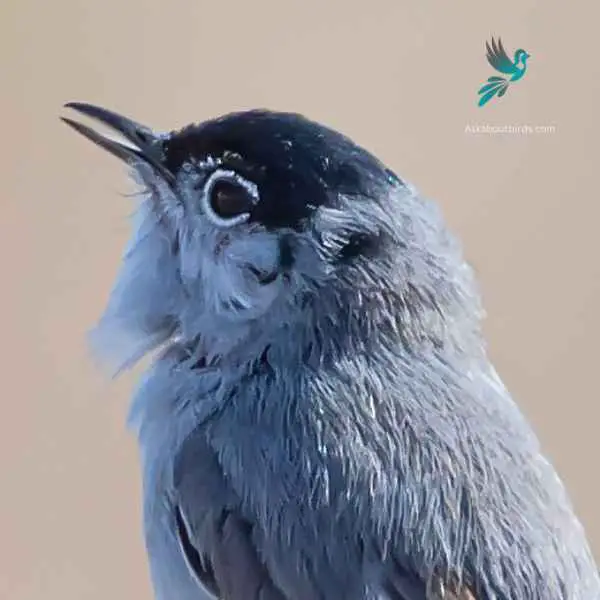
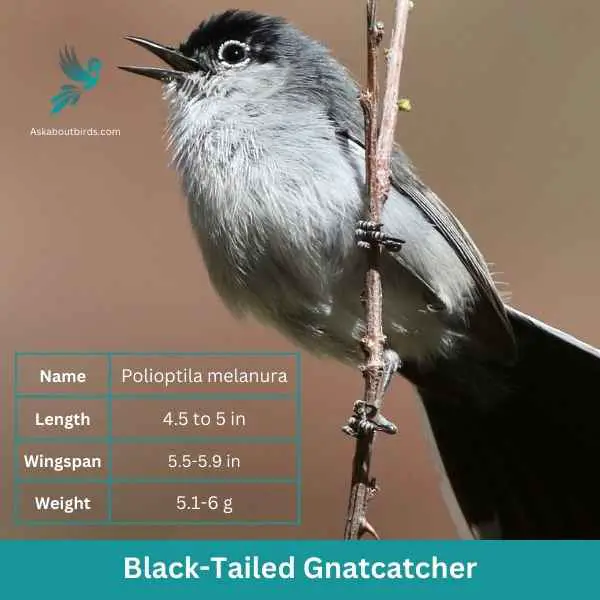
| Feature | Measurement |
|---|---|
| Scientific Name | Polioptila melanura |
| Length | 4.5 to 5 in |
| Wingspan | 5.5-5.9 in |
| Weight | 5.1-6 g |
The Black-tailed Gnatcatcher is a small and active songbird native to the arid regions of the southwestern United States and northern Mexico. With its overall gray plumage, white eye-ring, and long black tail, it possesses a distinctive appearance.
These gnatcatchers inhabit desert scrublands, arid grasslands, and thorny thickets. They are well-adapted to these harsh environments, where they forage actively for small insects, spiders, and other arthropods. Their slender bills and agile movements allow them to capture their prey with precision.
These birds produce a variety of soft, high-pitched calls and songs, often heard as they move through their habitats. Their vocalizations serve for communication and maintaining contact with their flock members.
Similarities
- Both species are insectivores, and their diet primarily consists of insects and spiders.
- They are both active, small-sized birds that flit quickly from branch to branch.
- The black cap of the male Black-Tailed Gnatcatcher is somewhat reminiscent of the Chickadee’s black cap.
Differences
- Black-Tailed Gnatcatchers have a gray body with a black cap and tail, whereas Chickadees have a black cap and bib, white cheeks, and a gray back.
- The Black-Tailed Gnatcatcher’s range is mostly limited to the deserts of the southwestern United States and Mexico, while Chickadees have a broader range across North America and prefer wooded habitats.
Black-Throated Sparrow

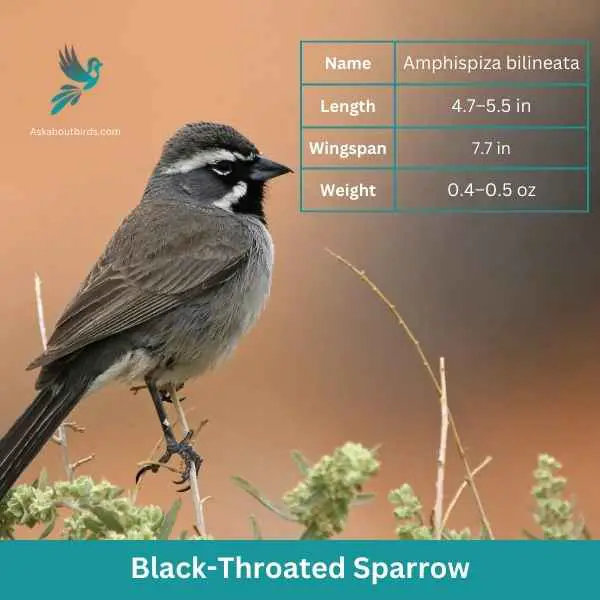
| Feature | Measurement |
|---|---|
| Scientific Name | Amphispiza bilineata |
| Length | 4.7–5.5 in |
| Wingspan | 7.7 in |
| Weight | 0.4–0.5 oz |
The Black-throated Sparrow is a small songbird native to the arid regions of the southwestern United States and northern Mexico. With its grayish-brown plumage, white underparts, and a distinctive black patch on its throat, it has a recognizable appearance.
These sparrows inhabit desert scrublands, rocky slopes, and arid grasslands. They are well-adapted to the harsh desert environment, where they forage for seeds and insects. Their diet consists mainly of grass seeds, but they also feed on insects such as beetles, grasshoppers, and ants.
Black-throated Sparrows are known for their melodious songs, which include a series of clear, high-pitched notes. Males often sing from exposed perches to defend their territories and attract mates. They also engage in courtship displays, showcasing their plumage and vocal abilities.
Similarities
- Both species have distinctive black-and-white patterns on their heads.
- They are both small, songbirds known for their melodious calls.
- Both species are hardy and adaptable to a variety of conditions.
Differences
- Black-Throated Sparrows have a distinctive black throat and white face with a black stripe, contrasting with the Chickadee’s black cap and bib, white cheeks, and gray back.
- Black-Throated Sparrows are commonly found in desert habitats, which is different from the Chickadee’s preference for wooded areas.
Blue-gray Gnatcatcher

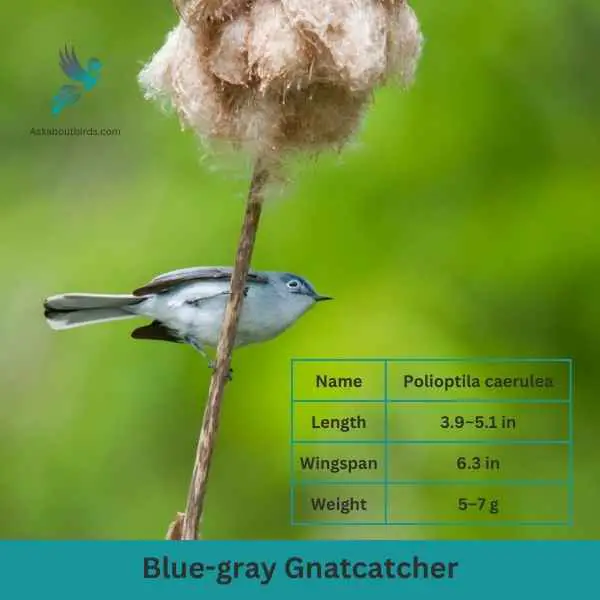
| Feature | Measurement |
|---|---|
| Scientific Name | Polioptila caerulea |
| Length | 3.9–5.1 in |
| Wingspan | 6.3 in |
| Weight | 5–7 g |
The Blue-gray Gnatcatcher is a petite, active bird, frequently observed flitting about treetops, emitting its distinctive high-pitched calls as it moves agilely through the branches.
Appearance: This bird exhibits a predominantly blue-gray plumage with a subtle white eye ring and long, slender tail feathers. The tail has distinctive black and white edging, with the males sometimes showing a faint black line on their forehead during the breeding season.
Diet: Blue-gray Gnatcatchers primarily feed on small insects and spiders. They’re adept hunters, foraging actively among foliage and even catching insects in mid-air.
Reproduction: These birds weave compact, cup-shaped nests on tree branches using plant materials, spider webs, and lichen. The exterior of the nest often matches the tree bark, making it well camouflaged. Inside, the female lays a clutch of 3 to 5 blue or greenish eggs, which she incubates.
Similarities
- Both species are insectivores, often seen flitting around tree branches looking for their next meal.
- They both have a relatively long tail for their size, which they often flick while moving about.
- Their size and overall shape are fairly similar, being small and somewhat compact birds.
Differences
- Blue-Gray Gnatcatchers have a blue-gray body with a white eye ring and a long, thin tail with white outer tail feathers, whereas Chickadees have a black cap and bib, white cheeks, and a gray back.
- Blue-Gray Gnatcatchers prefer deciduous forests and scrub, whereas Chickadees can be found in a variety of wooded habitats.
Blackpoll Warbler


| Feature | Measurement |
|---|---|
| Scientific Name | Setophaga striata |
| Length | 4.9 to 5.9 in |
| Wingspan | 7.9 to 9.8 in |
| Weight | 0.34 to 0.74 oz |
The Blackpoll Warbler is a small migratory songbird known for its remarkable long-distance journeys. During the breeding season, the male Blackpoll Warbler displays a black cap on its head and contrasting black streaks on its white underparts. Females have a similar pattern but with more subdued colors.
These warblers breed in the boreal forests of North America, primarily in Canada. They construct cup-shaped nests on tree branches, often hidden among the foliage. Blackpoll Warblers are insectivorous, foraging actively in the treetops as they search for insects and spiders to fuel their energy during migration.
Similarities
- Both species are insectivores and are known for their ability to catch insects in mid-air.
- They are both small songbirds that can be found in forested areas.
- The Blackpoll Warbler’s black cap can be reminiscent of the Chickadee’s black cap.
Differences
- Blackpoll Warblers have a black cap, white cheeks, and striped underparts, while Chickadees have a black cap and bib, white cheeks, and a soft gray back.
- Blackpoll Warblers are primarily insectivores, while Chickadees have a more varied diet that includes seeds and berries.
- Blackpoll Warblers have one of the longest migration routes of any songbird, while Chickadees tend to stay within their range year-round.
Gray-Headed Chickadee


| Feature | Measurement |
|---|---|
| Scientific Name | Poecile cinctus |
| Length | 6 inches |
| Wingspan | 6-8 inches |
| Weight | 11–14.3 g |
The Gray-headed Chickadee, also known as the Siberian Tit, is a small passerine bird native to the boreal forests of Alaska, Canada, and Eurasia. Classified under the family Paridae, this species is distinctively known for its grayish-brown head, black bib, and pale underparts.
Their behavior, similar to other chickadees, involves acrobatics while feeding and a penchant for concealed habitats, often in dense coniferous woods. These birds exhibit an impressive survival mechanism in extreme cold weather conditions, storing a substantial amount of food for the harsh winter months.
Carolina Chickadee
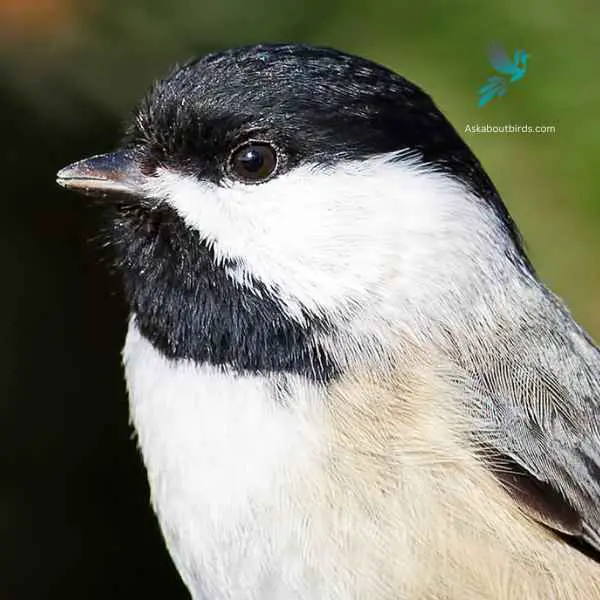

| Feature | Measurement |
|---|---|
| Scientific Name | Poecile carolinensis |
| Length | 4.5–5.1 in |
| Wingspan | 6-8 in |
| Weight | 9–12 g |
The Carolina Chickadee, a native songbird of the southeastern United States, is a part of the Paridae family. They are recognized by their black caps and bibs, contrasted by their white cheeks, and their soft gray wings and tail. They are famed for their complex vocalizations which include a distinctive four-note whistle and a variety of chick-a-dee calls, each with different meanings and purposes.
These birds are primarily found in deciduous and mixed forests, often seen flitting about tree canopies in search of food. They mainly feast on insects, seeds, and berries, but during winter, they can be seen frequenting bird feeders. Carolina Chickadees are known to be monogamous, with pairs remaining together for several years. Their nests, often hidden in tree cavities or artificial nest boxes, house 3-10 white eggs speckled with reddish-brown spots.
Mountain Chickadee
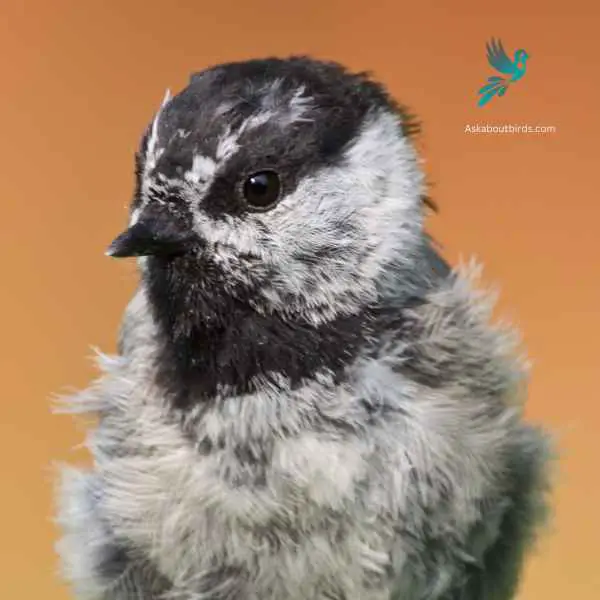

| Feature | Measurement |
|---|---|
| Scientific Name | Poecile gambeli |
| Length | 5–6 in |
| Wingspan | 7.5 in |
| Weight | 9-14 g |
The Mountain Chickadee is a small bird species belonging to the Paridae family, found primarily in the mountainous regions of the western United States and Canada. They are easily identified by their white eyebrows that contrast with their black caps and bibs, making them distinct from other chickadee species.
Mountain Chickadees are adaptive and can thrive in coniferous forests at high altitudes. They have a varied diet that includes insects, spiders, and seeds, and they’re known for their agility in feeding, often seen hanging upside down on branches. These birds are monogamous, often breeding in cavities within trees, with nests that hold 6-9 small, white eggs speckled with reddish-brown spots.
Boreal Chickadee

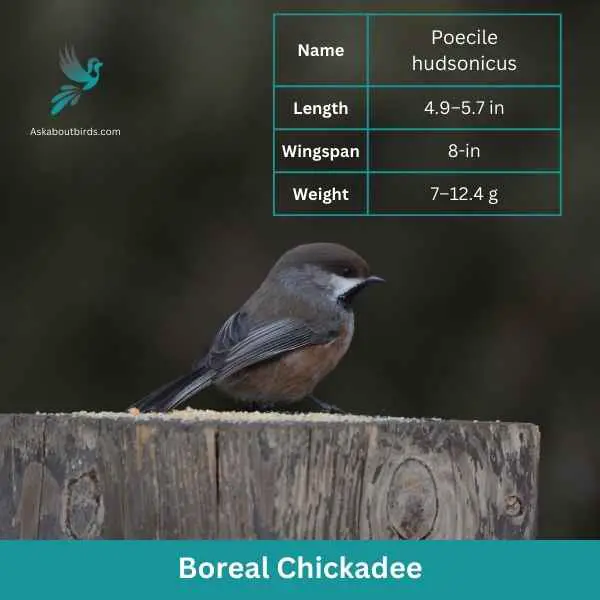
| Feature | Measurement |
|---|---|
| Scientific Name | Poecile hudsonicus |
| Length | 4.9–5.7 in |
| Wingspan | 8-in |
| Weight | 7–12.4 g |
The Boreal Chickadee, a small passerine bird in the family Paridae, is mainly found in the boreal forests of Canada, Alaska, and the northern United States. It’s marked by its brown cap and grayish-brown wings and tail, setting it apart from other chickadee species which typically sport black caps.
The bird’s habitat is tightly linked to spruce and other coniferous forests, where it feeds on a diet of insects, seeds, and berries. Boreal Chickadees, much like their relatives, are cavity nesters. They are known for their monogamous breeding habits, with both parents caring for the brood of usually 6-8 eggs. They have a distinctive “chick-a-dee” call that sounds more musical than that of their counterparts.
Black-Capped Chickadee
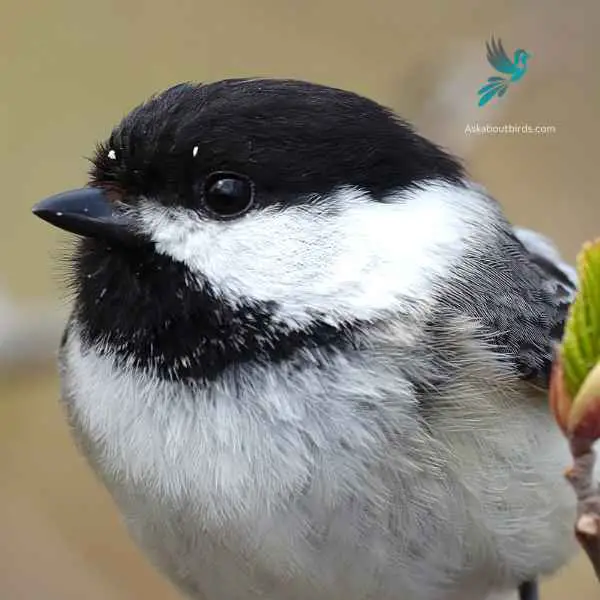
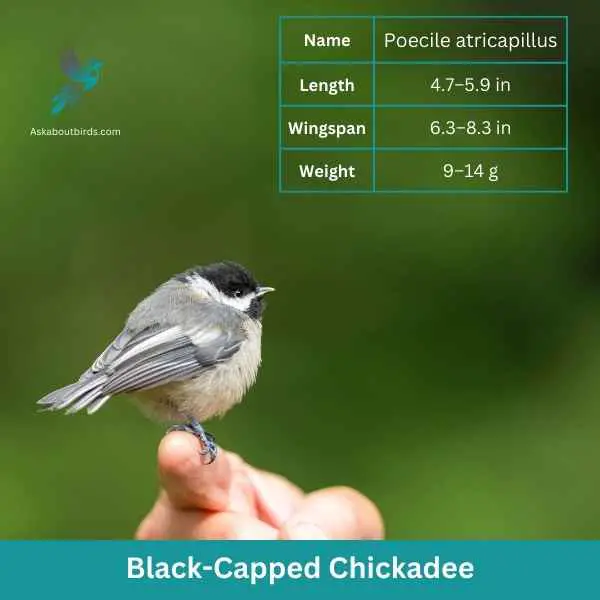
| Feature | Measurement |
|---|---|
| Scientific Name | Poecile atricapillus |
| Length | 4.7–5.9 in |
| Wingspan | 6.3–8.3 in |
| Weight | 9–14 g |
The Black-capped Chickadee is a small, North American songbird, part of the family Paridae. The species is easily recognized by its black cap and bib, white cheeks, and soft gray back, wings, and tail. Their distinctive “chick-a-dee-dee-dee” call, which varies in intensity, is a familiar sound in their habitats.
Inhabiting mixed or deciduous forests, Black-capped Chickadees feed on a diet rich in insects, seeds, and berries. They are also famous for their acrobatic feeding antics. Nesting typically occurs in tree cavities or nest boxes, where 6-8 white eggs, adorned with fine reddish-brown spots, are laid. These birds exhibit a monogamous mating system, with pair bonds often lasting several years.
Chestnut-Backed Chickadee
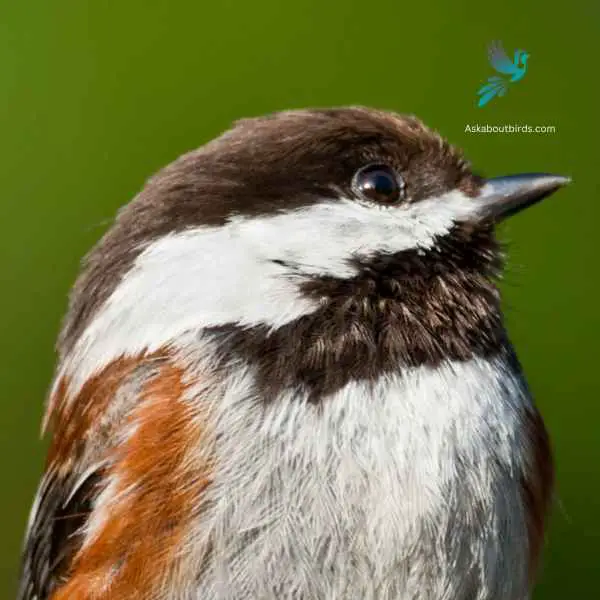

| Feature | Measurement |
|---|---|
| Scientific Name | Poecile rufescens |
| Length | 4.5–4.9 in |
| Wingspan | 7 in |
| Weight | 8.5–12.6 g |
The Chestnut-backed Chickadee, part of the family Paridae, is native to the Pacific Northwest of the United States and western Canada. This bird distinguishes itself from other chickadees with its rich chestnut brown back and flanks, contrasting with its white underparts and black cap and bib.
Typically inhabiting moist, coniferous forests, the Chestnut-backed Chickadee feeds on a variety of insects, seeds, and berries, and is known for its acrobatic feeding style. Their nests are typically built in tree cavities or nest boxes, where the female lays between 5-8 small white eggs, speckled with reddish-brown. The species is recognized for its distinctive, complex calls and songs, contributing to the rich avian symphony of its habitat.
Mexican Chickadee

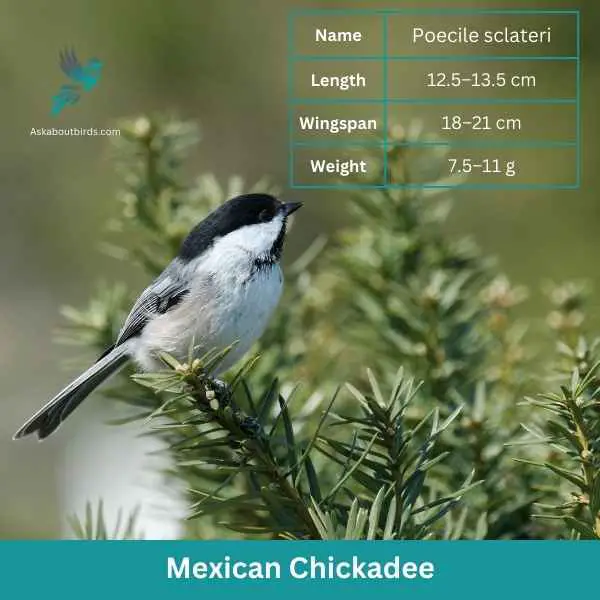
| Feature | Measurement |
|---|---|
| Scientific Name | Poecile sclateri |
| Length | 12.5–13.5 cm |
| Wingspan | 18–21 cm |
| Weight | 7.5–11 g |
The Mexican Chickadee is a unique songbird belonging to the family Paridae. Predominantly found in Mexico’s high mountainous regions, it extends its range into the southwestern United States, particularly in parts of Arizona and New Mexico. This bird is identifiable by its black cap and bib, contrasting with its white cheeks and grayish-brown wings and tail.
In terms of habitat, Mexican Chickadees favor pine and pine-oak forests, where they actively forage for insects, spiders, and seeds. These birds are known for their acrobatic feeding behavior, similar to other chickadee species. They nest in tree cavities, usually lined with soft materials like moss and fur. Mexican Chickadees, like their relatives, are monogamous, with both parents sharing the responsibilities of raising their young. Their distinctive song consists of a series of clear, whistled notes, contributing to the vibrant soundscape of their habitats.
FAQS on Birds that look like chickadees
What bird looks like a chickadee?
The Black-tailed Gnatcatcher and the Tufted Titmouse are two birds that bear a resemblance to the Chickadee. Both are small birds with grayish-brown wings. The Black-tailed Gnatcatcher, a tiny bird common in Western North America, sports a black tail and cap, while the Tufted Titmouse, which is fairly common in the Eastern United States, features a gray cap. These two birds, similar to the Chickadee, are easily recognizable and favored by bird watchers.
What is the black and white bird similar to the chickadee?
The Blackpoll Warbler is a bird that is similar in appearance to the Chickadee. Like the Chickadee, it has a black cap and bib, white underparts, and grayish-brown wings. It’s about the same size as a Chickadee, making it an easily recognizable bird for nature lovers. The Blackpoll Warbler breeds in the Boreal forests of Northern North America and winters in Central and South America.
How to tell the difference between a nuthatch and a chickadee?
Although the Nuthatch and the Chickadee are both small birds that can often be seen around bird feeders, there are a few key differences. The Chickadee has a distinctive black cap and bib, with white underparts and grayish-brown wings. In contrast, the Nuthatch has a gray cap, and its eyes are outlined by a black stripe. Nuthatches have a habit of climbing down tree trunks headfirst, which is behavior you won’t typically see in Chickadees.
Are there different types of chickadees?
Yes, there are several different species of Chickadees. In North America, the most common are the Black-capped Chickadee, the Carolina Chickadee, the Mountain Chickadee, the Chestnut-backed Chickadee, and the Boreal Chickadee. Each of these species has slightly different colorations and markings, but all share the black cap and bib that is characteristic of the Chickadee. Their habitats also vary, with some preferring deciduous and mixed forests, others living in coniferous forests, and some even residing in tree cavities.
What are some key differences between the Blackpoll Warbler and the Chestnut-backed Chickadee, and where can each be commonly found?
The Blackpoll Warbler and the Chestnut-backed Chickadee are two easily recognizable birds for nature lovers and bird watchers. Both species have distinctive features and inhabit different regions of North America.
The Blackpoll Warbler, commonly found in the boreal forests of Northern North America, particularly in the Northern United States and Southern Canada, is known for its black cap and throat, white underparts, and black tail. Its dark eyes stand out against its white face. The Blackpoll Warbler typically inhabits deciduous and coniferous forests and is known to be a bird that migrates to Eastern North America. This bird eats insects as its primary food source.
The Chestnut-backed Chickadee, which has a black cap, black throat, and white underparts, can often be spotted in the dense coniferous forests of Western North America, from Southern California to Southern Canada. The bird is easily recognizable from other birds due to its chestnut-brown back and flanks. Its natural habitat is in dense forests, whether coniferous or mixed, and like other bird species, it feeds on insects and seeds.
While both these birds share a few similar traits, their geographic range, preferred habitats, and coloration make them distinct from each other like many dark brown other birds.




